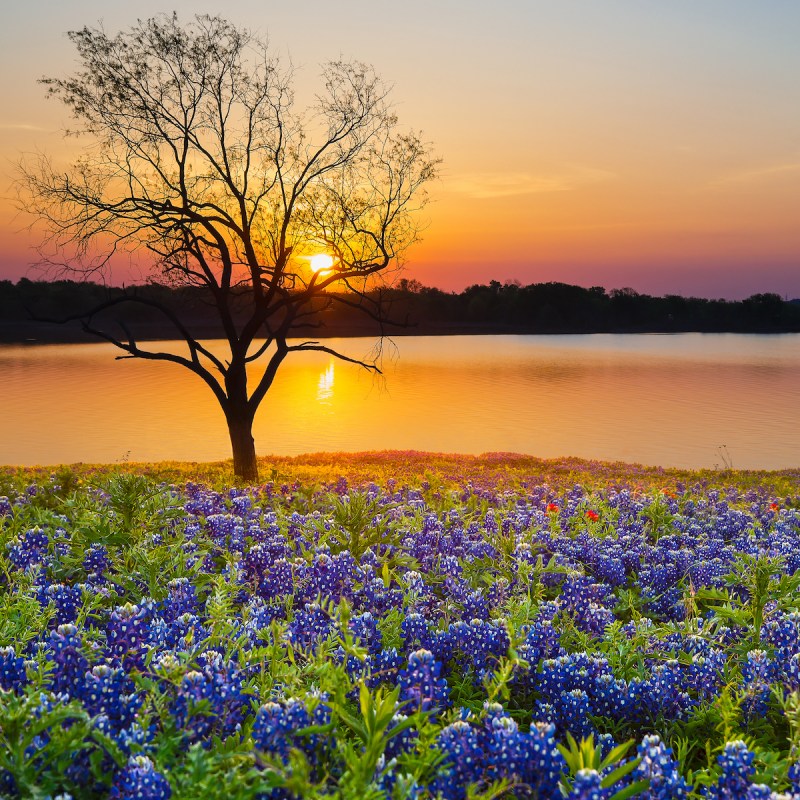
You don’t have to be from Texas to know that bluebonnets are a sign of spring. Some of the most beautiful sights in Texas are fields of bluebonnets. Travelers come from all over to wander through the backroads of Texas in search of the perfect batch of bluebonnets for that annual photo of the family all dressed up in their spring outfits.
Videos by TravelAwaits
In my lifetime as a native Texan, I’ve seen many families pull off the highway to capture their little ones rollicking around in the bluebonnets. It’s true, beautiful bluebonnets can be seen from highways and byways, but I think road-tripping to small towns that hold official bluebonnet titles is the best way to experience them, don’t you?
At the end of March, the bluebonnets start to perk up here in Texas, but the peak season is the first or second week in April. If you weren’t aware, the bluebonnet season doesn’t last long around here. So, come spring, the hunt is on for the perfect batch of pretty blue flowers to enjoy however you like. Begin planning your road trip somewhere in Texas with these seven best towns in Texas to see our beloved state flower. Also, if a town hosts an annual bluebonnet festival, I’ve noted it.
1. Cedar Hill State Park
Dallas County
Minutes from Dallas is a wonderful state park for hiking and biking in rolling tallgrass prairie. But it’s even nicer to hike, bike, run, walk among the beautiful bluebonnets of North Texas. You can do just that in the spring. And, where there are bluebonnets, there are also bluebirds. Visit Cedar Hill State Park to see fields of bluebonnets in several areas throughout the 1,200 acres of the park, and perhaps you’ll spot a few bluebirds. Most trails are easy to access and are well-maintained. A small fee will apply to enter the state park.
Pro Tip: The trails close when wet, so it’s best to call ahead of time at (972) 291-3900 to make sure they are open. Bring your leashed dog along to accompany you.
2. Ennis, Official Bluebonnet City Of Texas
Southeast Of Dallas
The city of Ennis goes all out when the bluebonnets bloom — and for good reason. Ennis, a small town about 40 minutes east of Dallas is where blankets and blankets of bluebonnets spring up every year, and 100,000 visitors flock to the area to see it all. For this reason, Ennis is known as the Official Texas Bluebonnet City and goes all out with a festival.
Ennis is also part of a trail that goes from Ennis to Corsicana, to Athens, onto Kaufman then back to Ennis. You’re likely to see more wildflower, such as Indian paintbrush, Arkansas lazy daisies, winecups, wild verbena, pink evening primrose, and larkspur. This is my favorite route to view the bluebonnets because it’s the way I go to visit my mother. My family has actually traveled parts of this route since the ’70s, making our way to our lake house on Cedar Creek Lake, so we’ve seen a few of its bluebonnets and other wildflowers in our time.
The best time to see how Ennis goes all out for bluebonnets is during the full month of April when their annual Bluebonnet Trails Festival is going on.
Pro Tip: If you’re following the trail, you may want to plan to spend a day in Athens to see the beautiful azaleas at the East Texas Arboretum and Botanical Society.

3. Chappell Hill
Northwest Of Houston
Chappell Hill, a historical community right in the heart of bluebonnet country, hosts what’s recognized as the Official Bluebonnet Festival of Texas by the Texas Legislature. Its Bluebonnet Festival is normally held on the second weekend in April and is the largest festival in Washington County. The bluebonnets are in full bloom by then, and the festival is full of entertainment for the whole family.
Afterward, you may want to make a stop in the next town over (to the west) to see why Brenham is a very charming town to spend a day and perhaps stroll the historical downtown or enjoy a glass of wine at the Pleasant Hill Winery. If nothing else, it’s worth a drive to visit the Blue Bell Creamery.

4. Llano, Burnet, Marble Falls
Hill Country
The peak season to see fields of bluebonnets in Texas Hill Country is usually around the beginning of April, mostly in these three towns. Luckily, all three are minutes apart from each other, and the scenic drive is marvelous! Llano and Burnet share The Bluebonnet Capital of Texas title and celebrate its annual Bluebonnet Festival in Burnet during the second weekend in April. Everything from live music to a parade, arts and crafts vendors to a wildflower show, and more. They go all out here!
Travel a little further down on Highway 281 to beautiful Marble Falls to see more flowers. But, for a better idea of where the best fields of bluebonnets are located, Marble Falls Visitor Center maintains a large bluebonnet map that’s updated daily.
Pro Tip: To get a full dose of spring bluebonnets, have lunch at the Blue Bonnet Cafe in Marble Falls and order one of their world-famous pies.

5. Wildflower Celebration At Wildseed Farms
Fredericksburg
During the bluebonnet growing season, a true Texas tradition is observed at Wildseed Farms in Fredericksburg. If traveling to Fredericksburg via Austin on Highway 290, you’ll come to Wildseed Farms first. If I don’t stop there first, I’ll make a quick stop during my trip to see what new Texas souvenirs and memorabilia they have. There’s one thing for sure; there will be a bluebonnet or two on just about everything they sell! So, Wildseed Farms is a perfect place to stop to enjoy the bluebonnets and buy cute Texas gifts for yourself and everyone you know. While there, be sure to check out the Bluebonnet Tractor Ride. Nice restrooms are available inside the store.
Pro Tip: Before you go, check out these Best Things To See And Do In Fredericksburg, so you’ll know what not to miss!
6. Natalia
Southwest Of San Antonio
A little over 27 miles from San Antonio on IH-35 is the Queen City of the Southwest known as Natalia. A small community in South Texas beaming with local pride and — you guessed it — bluebonnets! They start to see bluebonnets in late March. The Natalia Bluebonnet Festival and Parade is an annual event that’s celebrated on the last Saturday of March. Everyone in Natalia comes out and helps support their library during this time.
On your road trip to Natalia, you’re likely to see other vibrant and aromatic wildflowers. So, this is the time to get out and smell the wildflowers. Be careful if doing so.
7. Brushy Creek Lake Park
North Of Austin
One of the best-known spots around Austin to see Texas’s beloved native flower is Brushy Creek Lake Park. The park also features a kid- and pet-friendly walking trail, a nice playground, and a lake full of ducks that love to be fed. So grab the family and a picnic basket full of sandwiches and snacks and enjoy this park in the springtime.
Pro Tip: The Lady Bird Johnson Wildflower Center at the University of Texas at Austin would make a wonderful stop if time allows. You’ll be able to view 900+ species of native Texas plants in the garden and elsewhere. The center is open year-round.

Fun Facts About Bluebonnets
- Bluebonnets were named Texas’s official state flower in 1901.
- Bluebonnets usually spring up at the end of March and stay around until May.
- Each floret on the bluebonnet plant looks like a small bonnet.
- There are six varieties of bluebonnets in Texas, and all their official names start with the word Lupinus.
- The bluebonnet is both a perennial and an annual plant and thrives in warmer weather.
- The most common variety has vivid royal blue flowers, while the florets have white tips.
- It is not illegal to pick bluebonnets, though many Texans and out-of-towners think it is.
Pro Tips
Though the blooms depend much on the rainfall, there’s never been a bluebonnet season that I haven’t seen here in Texas. So rest assured, our beloved state flower will poke itself out long enough and vibrant enough for you to enjoy and snap photos of your loved ones jumping and frolicking in the midst of them. If you want to pick a few, bring along something to put them in and leave the rest so they can grow next year. Also, note that it is not okay to pull over to pick flowers on private property.
Editor’s Note: Kim’s fun facts about bluebonnets are inspired by this 2016 Country Living bluebonnet article.
Related Reading:
